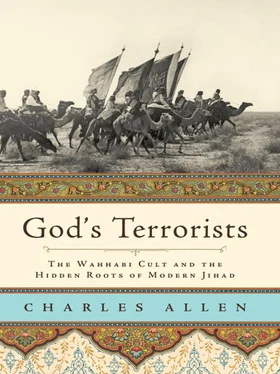Because of the name Mackeson had made for himself among the frontier tribes, his friends found his murder incomprehensible. There were rumours, angrily dismissed, that the Commissioner had violated Pathan taboos by making advances to one of their women. There was also talk of a fatwa or religious edict having been proclaimed, and of a reward being offered for his head. The reality was that the murder was both an act of revenge and the first successful blow against the British Government in India by a secret organisation intent on revolution.
This organisation was, in fact, already known to the authorities. Back in 1848 Lieutenant Harry Lumsden had reported the presence of Hindustani outsiders among the Sayyed tribesmen of Hazara. He had captured their two leaders – two brothers named Ali – who after questioning had been returned under custody to their homes in Patna. Then in August 1852 the Assistant Magistrate of Patna, Charles Carnac, had sent details to the Governor-General of a plot involving a sect of Muslims in his city who were ‘mixed up with a band of Moslem fanatics in the distant hills of Sittana and Swat’. A bundle of letters had been intercepted which revealed that a ‘treasonable correspondence’ was taking place between these fanatics in the mountains and members of a prominent Muslim family living in the Sadiqpore district of Patna. The latter were apparently despatching kafilas or caravans of men, arms and funds to the frontier along a secret trail that went from Patna to Peshawar by way of Meerut, Amballa and Rawalpindi, for the express purpose of waging war against the Government of India.
Acting on this information, Mr Carnac had raided the Sadiqpore mansion-cum-caravanserai in Patna, only to find that the occupants had been forewarned and had destroyed all their letters. However, the head of the family, one Maulvi Ahmadullah, had subsequently assembled several hundred armed men in his premises and had declared that ‘he was prepared to resist any further prosecution of the Magistrate’s enquiries and, if attacked, would raise the standard of revolt’.
After taking advice from his home minister and members of his council, Lord Dalhousie had then set out a formal Minute in Council in which he expressed himself satisfied that there was no cause for concern. For years these fanatics had been doing their best to ‘induce the Mussulmans [Muslims] in India to join in a holy war’ and nothing had come of it: ‘The letters now detected seem to me to show that their efforts have met with very little success. They ask for money, they ask for arms and recruits, and the terms in which they write seem to me conclusive of the fact that they have obtained very little of the one and very few of the other.’ The Governor-General had himself seen ‘a sort of ballad’, picked up in the back streets of Calcutta, which enjoined ‘all true Mussulmans to join the standard of the faith and rise against the infidel’. But that sort of thing was only to be expected. His Lordship could see ‘no reason to suppose that there is any more movement or intrigue at present going on than must at all times be expected among the Mussulmans in India’.
This first Minute had then been followed by a second, written by Dalhousie in October 1852 in response to further discoveries of treasonable activities, now involving attempts to subvert sepoys of the Bengal Native Infantry on service in the Punjab. Again, the evidence pointed to a group of Muslim mullahs in Patna being deeply involved in treasonable conspiracy against the state. But Government, according to Dalhousie, was on top of the situation, and the law as it existed was fully capable of dealing with it. Instructions were subsequently sent to all the provinces under British rule reminding the local authorities how they were to deal with such cases. Where it could be proved that treason was being plotted, the ringleaders of plots were to be shown no leniency – but magistrates were to avoid taking any action that might be seen as oppressive by the native population. As for the fanatics up in the Mahabun Mountain at Sittana, they were best left untouched: ‘Since they are insignificant, they may be let alone as long as they are quiet. At any rate, this is not a propitious time for such a movement. We have already irons enough in the fire on the north-west frontier without heating another unnecessarily.’
Barely eight weeks after the Governor-General recorded this second Minute, Commissioner Mackeson had himself led a small punitive force across the Indus River from British territory in Hazara. This was in response to an appeal from a local tribal chief, the Khan of Amb: some Hindustani foreigners had occupied one of his forts on the banks of the Indus and he needed help to expel them. These Hindustanis were the same Moslem fanatics of Sittana of whom the Magistrate of Patna had complained eighteen months earlier. Among the officers who accompanied Mackeson on this raid was a young lieutenant of the 41st Bengal Native Infantry, George Rowcroft, for whom it was his first taste of frontier warfare. ‘Sittana’, he wrote in a private memoir, ‘was a place built and inhabited by Mahomedan Hindustanis and Bengalis; refugees and outlaws, men who had left the British territories either as criminals fleeing from justice, or as fanatics renouncing the “Feringee” [the British] and all his works. They were a thorn in the side of the civil and political authorities on the Frontier, and made frequent raids across the Indus into British territory, often succeeding in carrying off, for ransom, some of our subjects; generally a Hindu trader.’ Having kidnapped a victim they would send a ransom demand to his relatives and, if this wasn’t answered, follow up with a second message accompanied by the victim’s ear: ‘A further neglect to pay up resulted in the head of the victim being sent, and a sarcastic message that they were now relieved of the expense of feeding him.’
Ordered by Mackeson to give up the Khan of Amb’s fort, its Hindustani occupants responded with a defiant letter declaring that they would die first. Accordingly, on 6 January 1853 two regiments of Sikh infantry were ferried across the Indus and advanced on the fort from below, while at the same time a party of matchlock-men supplied by the Khan of Amb took up a position on the heights above. The sight of columns of troops advancing in good order was enough to send the occupants scurrying up the mountainside. ‘In spite of the boasts of the Hindustanis,’ wrote Colonel Mackeson in his official despatch, ‘they were all, to the number of from 200 to 300, in full flight from the fort of Kotla.’ In the meantime, the Khan of Amb’s matchlock-men had seized the Hindustanis’ main base at Sittana, higher up in the mountains. But here, too, the Hindustanis dispersed into the surrounding crags and ravines, leaving behind a small rearguard party to hold off the attackers. According to George Rowcroft’s account, by the time the Sikhs arrived the fighting was over: ‘The latter, on arriving at Sittana – a partially fortified village surrounded by a dense belt of dried thorns – found that the able bodied portion of the occupants had fled, and the few (some dozen or fifteen of sick and wounded) left behind, had been promptly disposed of by the gallant Tunawallis.’
The camp at Sittana was levelled, the belt of thorns fired, and the expedition withdrew, taking with it a number of wounded prisoners. In Peshawar the Guides’ Assistant Surgeon, Dr Robert Lyell, treated these wounded men and was impressed by their fortitude and their refusal to talk. Only after one of his nursing assistants had gained their confidence did they begin to give information about themselves and their organisation, whereupon it became clear that this was no rabble of outlaws but a disciplined army, well organised and with a clear agenda. It had an established chain of command, and was currently led by the younger of two brothers named Ali following the recent death of the elder brother. Although they lived frugally on stewed pulses and unleavened bread, they were armed with carbines and were kept well supplied by their supporters in the plains. The prisoners boasted that many pious Muslims contributed to their cause, including the rulers of a number of leading Muslim princely states in India.
Читать дальше












